Publications

Practical considerations for standardized recording of muscle mechanical properties using a myometric device: recording site, muscle length, state of contraction and prior activity
Authors: Sandra Agyapong-Badu, Martin Warner, Dinesh Samuel, Maria Stokes
Affiliations: School of Health Sciences University of Southampton, UK; School of Sport, Exercise and Rehabilitation Sciences University of Birmingham, UK; Arthrtis Research UK Centre for Sport Exercise and Osteoarthritis
Journal: Journal of Musculoskeletal Research - December 2018, Volume 21, Issue 2, Article ID 1850010, 13 pages (DOI: 10.1142/S0218957718500100)
-
Field & Applications:
- Medical
- Methodology
- Reliability
- Sport
- Validity
Purpose: This study aimed to systematically examine the influence of various muscle and experimental conditions on Myoton recordings.
Methods: A cross-sectional, observational design was used to examine muscle conditions and experimental factors (different recording sites, muscle length, level of contraction and prior physical activity) that may influence reproducibility of Myoton recordings for biceps brachii (BB) and rectus femoris (RF). Fifty-three healthy adults (26 young, 27 older) aged 18–90 years were studied. Muscle stiffness, tone and elasticity were measured using the MyotonPRO device.
Results: Statistically significant differences in Myoton parameters were found for aspects of all four muscle and experimental conditions compared with the control condition (p < 0:05). However, clinically relevant differences in tone, stiffness and elasticity were only found for contracted compared to resting muscle, with changes being greater than the minimal detectable change. Elasticity was not affected by prior activity.
Keywords: Experimental conditions, Muscle elasticity, Muscle stiffness, Muscle tone, Validity.
The conditions studied significantly altered Myoton parameters of BB and RF in healthy adults, but only changes in parameters during muscle contraction were clinically relevant. These findings provide evidence to support the need to consider muscle condition and experimental factors for improving the robustness of test protocols for assessing muscle mechanical properties using the MyotonPRO device.
In conclusion, moving the Myoton probe away from the muscle midpoint, altering muscle length and level of contraction, and prior physical activity significantly altered mechanical tone and stiffness of BB and RF in healthy adults. Clinically relevant changes in Myoton parameters only occurred with altered level of contraction. The present findings have provided evidence that ensuring muscles are relaxed or under a constant force of contraction when using the Myoton technology to assess muscle properties is crucial. These findings will improve the robustness of existing protocols for assessing muscle mechanical properties using the MyotonPRO device.


